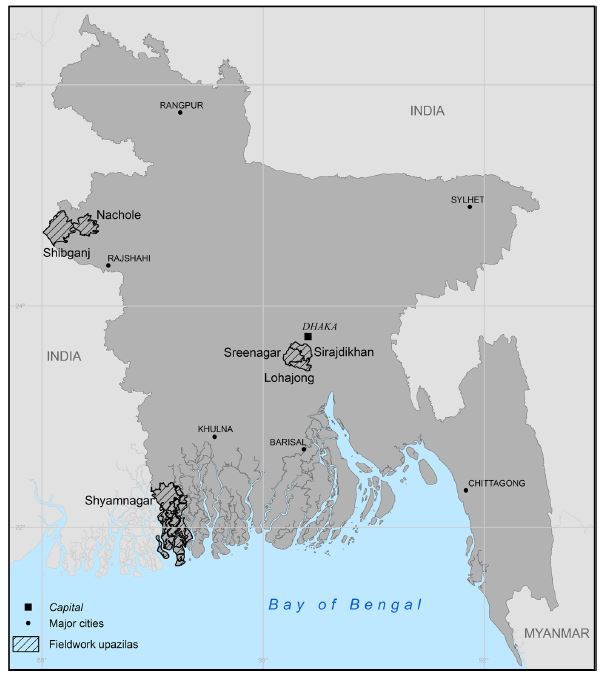Introduction
Environmental changes significantly impact the lives of people, forcing them to change the places of residence to adapt. Such weather-caused events as droughts, floods, tsunami, and other natural disasters lead to climate migration that can be defined as the necessity to leave habitual homes because of inappropriate living conditions (Bernzen, Jenkins, & Braun, 2019). In rural Bangladesh, the environmental factors are detrimental to climate migration since the region faces floods, scarcity of drinking water, and high cyclone frequency. Therefore, this paper provides a case study to clarify the current situation with environmental migration in rural Bangladesh.
Region Description
Bangladesh is a country located in South Asia, with the population of more than 163 million people and a growing economy. It is situated near Myanmar, Nepal, India, and Bhutan on the Bay of Bengal (Figure 1). The rural areas of Bangladesh include some parts of Satkhira District, Jamalpur District, and many several thousand villages across the country. Its population consists of Bengalis composing 98%, while it is one of the largest Muslim-majority countries in the world (Martin et al., 2014). There are eight administrative regions that are divided into 64 districts, while the officials are selected based on parliamentary elections. The climate of Bangladesh is tropical, its lands are rich, but the territory experiences tornadoes, floods, and other natural calamities every year. The most severe flooding events happened in 1998 and 2007, and the overall number of cyclones within the last 100 years was 508 (Stojanov et al., 2016). These expressions of climate change cause threats to public health, economy, agriculture, and living conditions.

Drivers of Environmental Migration in Rural Bangladesh
The rural areas of Bangladesh are mainly engaged in agriculture as the source of their provision for life. The overwhelming number of rainfalls, tropical cyclones, and rising sea levels cause natural disasters, which damages local agriculture (Bernzen et al., 2019). Namely, flooding and salinity make the survival in villages almost impossible. When the houses of people go in the water, they had no other opportunity but to become climate migrants. Urban areas become the centers of migration, where people try to find employment, rent living, and hope for returning to their homes in the next season (McDonnel, 2019). However, the conditions for migrants are not welcoming, and they usually live in slums, where families have to share one bed because of difficult financial positions.
Coastal erosion is another reason for climate change and associated environmental migration in rural Bangladesh. More than 140 km2 is impacted by river bank erosion, where the primary population is consists of small properties and farmers (Stojanov et al., 2016). As a result of erosion, flooding and blockages occur, destroying houses and lands. In addition, river flooding is one more driver of environmental migration, which is caused by snow melting and a lack of risk management systems.
Current State and Future of Climate Migration in Rural Bangladesh
Despite the damages brought by natural calamities in rural Bangladesh, the strategy of migration is not new for this country. Even though thousands of people move temporarily or decisively, the country lacks a special plan for mitigating the risks and helping the population (Walter, 2015). Nevertheless, Martin et al. (2014) assume that people view migration as the only effective adaptation strategy that is used to diversify their livelihoods.
While some members of the family are sent to cities, mainly its male and young representatives, others stay at home, which allows for achieving better preparedness for environmental disasters. In this connection, many families perceive migration as business-as-usual activity, not as something extremely risky. However, the findings of Bernzen et al. (2019) show that those people whose main occupation is not agriculture are more likely to migrate because of climate changes. The authors state that they have fewer rural ties and more assets to move, while people with farm-occupational skills have more difficulties with migration.
The environmental changes are defined as an ongoing process, the outcomes of which would worsen in the future. As mentioned by McDonnel (2019), “the corrosive effect of salinity on local agricultural economies could displace up to 200,000 people from coastal Bangladesh” within the next 120 years. According to Stojanov et al. (2016), by 2050, 6% of the territory would be submerged under the sea, and this number would increase to 13% by 2050. Therefore, there is a need to develop and implement monitoring, warning, and risk management systems, as well as elaborate policies that would help in supporting climate migrants.
Conclusion
To conclude, rural Bangladesh is characterized by a significant number of climate migrants, who have to move to urban areas because of environmental stressors. The key drivers of migration include flooding, cyclones, and river bank erosion. The engagement of rural areas in agriculture makes them more vulnerable to seasonal climate changes and forces them to leave their homes for seeking a better life. It is expected that climate change factors would worsen, which makes it important for Bangladesh authorities to develop and introduce well-designed strategies for managing risks and supporting the rural population.
References
Bernzen, A., Jenkins, J. C., & Braun, B. (2019). Climate change-induced migration in coastal Bangladesh? A critical assessment of migration drivers in rural households under economic and environmental stress. Geosciences, 9(1), 51-72.
Martin, M., Billah, M., Siddiqui, T., Abrar, C., Black, R., & Kniveton, D. (2014). Climate-related migration in rural Bangladesh: A behavioural model. Population and Environment, 36(1), 85-110.
McDonnel, T. (2019). Climate change creates a new migration crisis for Bangladesh. The National Geographic. Web.
Stojanov, R., Kelman, I., Ullah, A. K. M., Duží, B., Procházka, D., & Blahůtová, K. K. (2016). Local expert perceptions of migration as a climate change adaptation in Bangladesh. Sustainability, 8(12), 1223-1238.
Walter, P. (2015). Floods and rural-urban migration in Bangladesh. The State of Environmental Migration, 51-64.